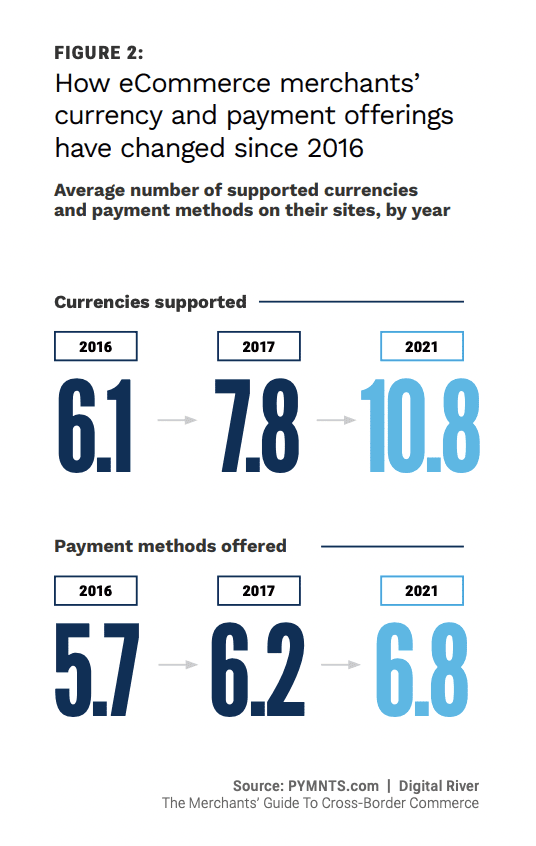
Payments localization is becoming more integral to cross-border eCommerce success as more merchants personalize checkouts for customers in different geographic locations. Supporting the right mix of currencies and payment options is becoming more paramount as merchants’ competitors add more of both.
A new study, The Merchants’ Guide To Cross-Border Commerce, a PYMNTS and Digital River collaboration, found that the average international eCommerce site supports 10.8 currencies for cross-border transactions in 2021 — 77% more than the average of 6.1 currencies supported in 2016.
It is also important that eCommerce merchants offer the right payment methods, those with which their potential customers are most familiar. So, the average merchant also allows international shoppers to pay using any of 6.8 payment methods in 2021, on average. That’s up from 5.7 payment methods in 2016.
 Merchants that accept more localized payment methods stand to convert more shoppers to new customers. It follows that the top merchants — the 30 merchants with the highest index scores in our sample — offer the broadest variety of currency and payment offerings.
Merchants that accept more localized payment methods stand to convert more shoppers to new customers. It follows that the top merchants — the 30 merchants with the highest index scores in our sample — offer the broadest variety of currency and payment offerings.
The top performers display the items on their websites in 24 different currencies for payments on average. In contrast, on the bottom 30 merchants’ sites, only four currencies are displayed on average.
In addition, top merchants offer nearly all payment methods more often than middle and bottom performers, with one notable exception: Amazon Pay. Only 5% of top merchants accept Amazon Pay, while 20% and 13% of middle- and bottom-performing merchants accept it, respectively.
 Payment localization is essential to gaining a competitive edge in the connected global economy. International eCommerce merchants must provide worldwide shoppers the payment options they prefer in their everyday lives. This means supporting currencies and accepting payment methods that are most common in their geographic areas.
Payment localization is essential to gaining a competitive edge in the connected global economy. International eCommerce merchants must provide worldwide shoppers the payment options they prefer in their everyday lives. This means supporting currencies and accepting payment methods that are most common in their geographic areas.